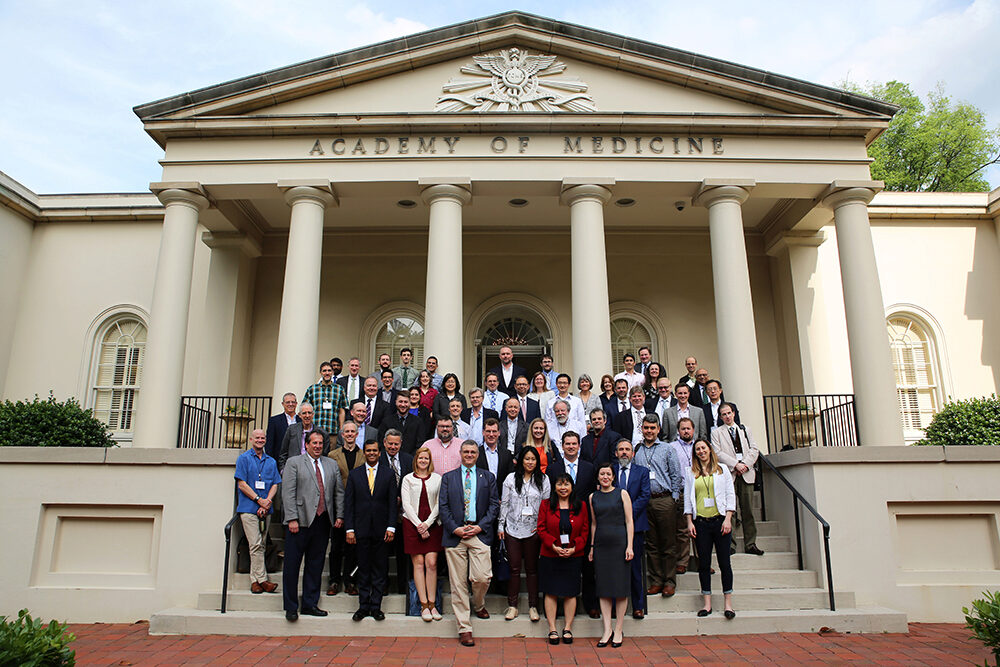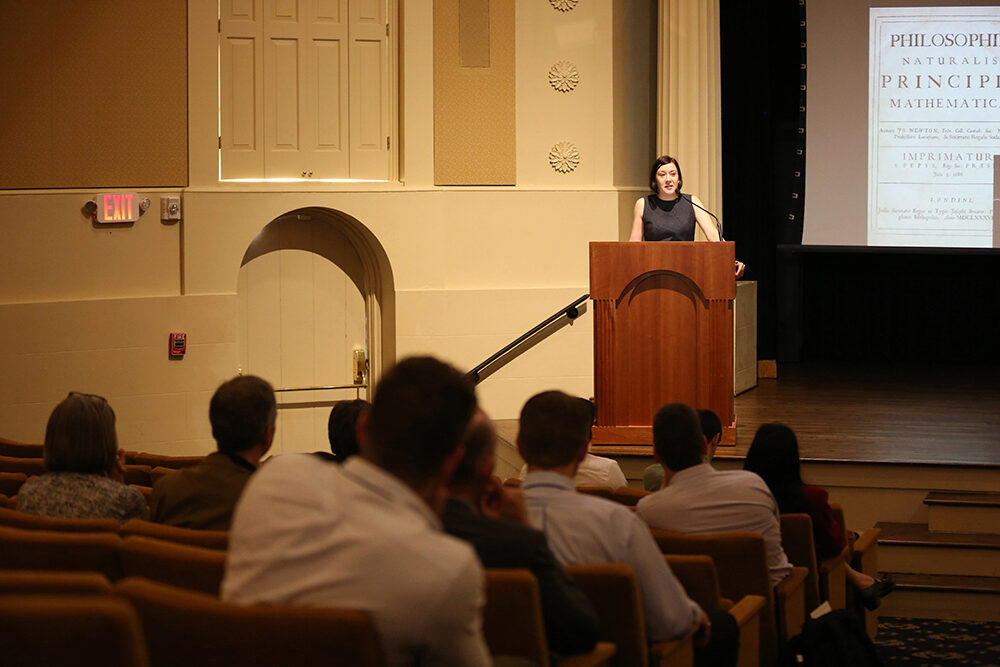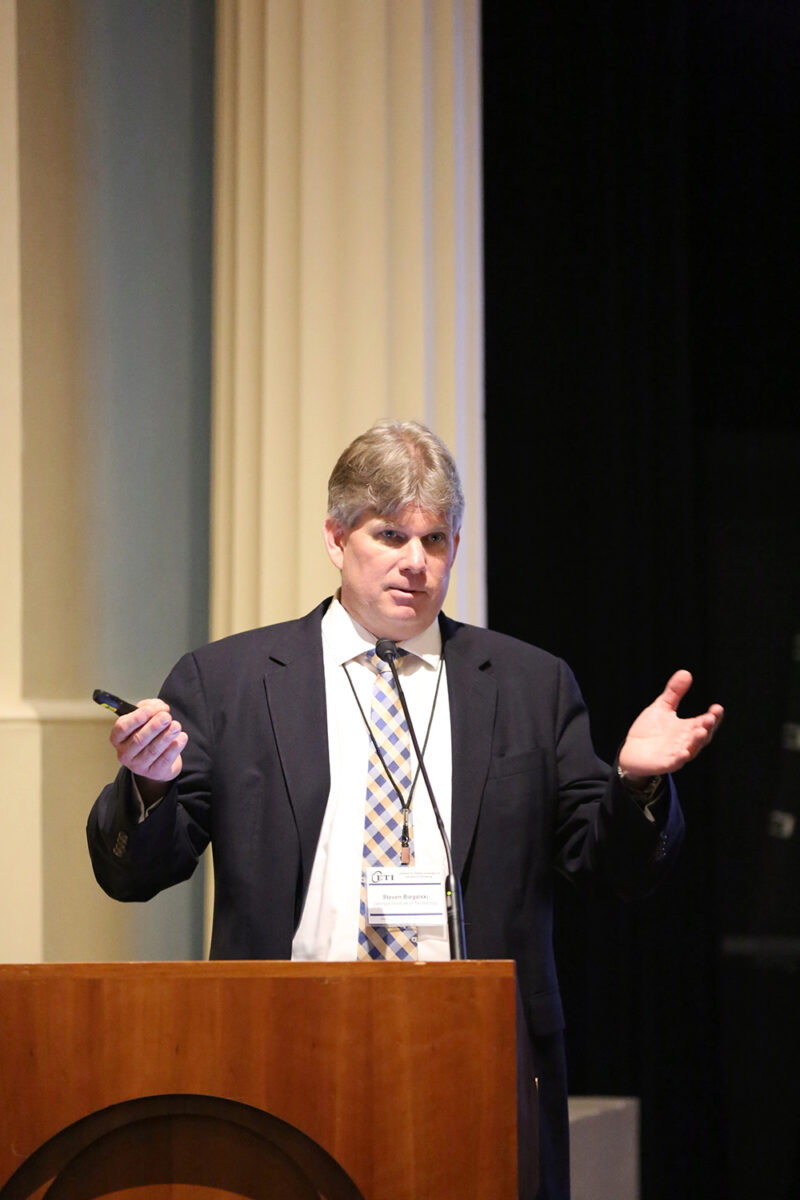
Last week, the Consortium of Enabling Technologies and Innovation (ETI) hosted a kickoff meeting at the Georgia Institute of Technology to officially launch the multidisciplinary collaboration. The meeting took place at the Historic Academy of Medicine and was attended by nearly 100 participants representing consortium partners, national laboratories and government.
The ETI Consortium is composed of 12 universities and 10 national laboratories led by Georgia Tech. The U.S. Department of Energy’s National Nuclear Security Administration (NNSA) awarded the consortium $25 million to develop new technologies and educational programs to support the agency’s nuclear science, security and nonproliferation goals.
The kickoff meeting was an opportunity for Consortium Director Dr. Anna Erickson, Associate Professor of Nuclear and Radiological Engineering at Georgia Tech, to introduce the vision and goals and to hear from university and laboratory partners as well as representatives from the NNSA. “We are honored and humbled by the opportunities presented through the ETI consortium to become an established pipeline of students and professionals to national laboratories and government and the hub for fundamental science transfer to the national laboratories,” she said during the opening address.

“I encourage you to use today as an opportunity to build and strengthen the research collaboration between the labs and the universities,” said Dr. Victoria Franques, University Program Manager for Defense Nuclear Nonproliferation R&D at the NNSA. “We expect through the ETI Consortium there will be novel research topics and exciting research results in the coming years.”
Additional speakers for the three-day event included:
- Dr. Chaouki Abdallah, Executive Vice President for Research, Georgia Tech
- Anant Agarwal, Professor, Electrical & Computer Engineering, The Ohio State University
- Steven Biegalski, Chair, Nuclear and Radiological Engineering and Medical Physics Program, Georgia Tech
- Raymond Cao, Professor, Nuclear Engineering Program, Director of OSU Nuclear Reactor Laboratory, The Ohio State University
- Brian Clowers, Associate Professor, Department of Chemistry, Washington State University
- Luke Erikson, Pacific Northwest National Laboratory
- Geoffrey Fairchild, Los Alamos National Laboratory
- John Fisher, Senior Research Scientist, Massachusetts Institute of Technology
- Milton Garces, Researcher, Hawai’i Institute of Geophysics & Planetology and Director of the Infrasound Laboratory (ISLA)
- Rob Goldston, Princeton Plasma Physics Laboratory
- Derek Haas, Assistant Professor, Mechanical Engineering, University of Texas at Austin
- Amit Jariwala, Director of Design & Innovation, Georgia Tech
- Bernard Kippelen, Joseph M. Pettit Professor and Director of Center for Organic Photonics and Electronics, Georgia Tech
- Vince Lordi, Lawrence Livermore National Laboratory
- Dr. Steven McLaughlin, Dean, College of Engineering, Georgia Tech
- Susan Pepper, Brookhaven National Laboratory
- Candido Pereira, Argonne National Laboratory
- David Peters, Sandia National Laboratories
- Craig Sloan, Director, Office of Proliferation Detection, Defense Nuclear Nonproliferation R&D, National Nuclear Security Administration
- Scott Thompson, Idaho National Laboratory
- John Valentine, Lawrence Berkeley National Laboratory
- David F. Williams, Oak Ridge National Laboratory
- Paul Wilson, Grainger Professor of Nuclear Engineering, Department of Engineering Physics, University of Wisconsin–Madison
Faculty co-PIs from partnering universities spoke on various topics related to the consortium’s three core disciplines: computer and engineering science research through machine learning and high performance computing, advanced manufacturing and nuclear detection technologies.

Further, a representative from each partnering laboratory gave an overview on how they will support the research activities of students, postdocs and faculty during their internships.
"The many opportunities to network with experts from the national laboratories allowed us to better understand how we can add value to their ongoing research activities," said Paul Wilson, Grainger Professor of Nuclear Engineering at University of Wisconsin–Madison and Thrust Area 1 lead within the ETI.
ETI’s educational goal is to transfer more than 40 graduate students and 20 undergraduate students to national laboratories or the NNSA over the next five years. As part of that strategy, it will provide approximately 70 internships, and establish multiple faculty-student laboratory visit fellowships.
In addition to Georgia Tech, the consortium includes the University of Wisconsin and The Ohio State University as leads of thrust areas, as well as the Massachusetts Institute of Technology, University of Michigan, University of Hawaii, Colorado School of Mines, Texas A&M University, University of North Carolina at Chapel Hill, Washington State University, Duke University and The University of Texas at Austin.
Laboratory partners include Argonne National Laboratory, Brookhaven National Laboratory, Idaho National Laboratory, Lawrence Berkeley National Laboratory, Lawrence Livermore National Laboratory, Los Alamos National Laboratory, Oak Ridge National Laboratory, Pacific Northwest National Laboratory, Princeton Plasma Physics Laboratory and Sandia National Laboratory.
For more information on the ETI Consortium, visit https://eti.gatech.edu/.
For more photos from the ETI Consortium Kickoff visit our Flickr gallery.
